Discover Florida Nature
It's time to explore the natural Florida


|
|
|
|
|
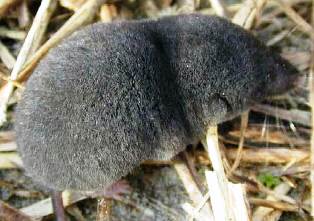 Homosassa
Shrew
(Sorex longirostris eionis) SSC- Although its external appearance is
generally that of a long-nosed mouse, a shrew is not a rodent and not
closely related to rodents. Shrew feet have five toes, while rodent feet
have four. Three species of shrews are found across Florida. The
Homosassa shrew is a subspecies of the Southeastern shrew and is found
in the Homosassa Springs area of Florida. The Homosassa shrew habitats
include herbaceous wetlands, mesic flatwoods, coastal zones and
adjacent uplands. In general, shrews are terrestrial creatures that
forage for seeds, insects, nuts, worms and a variety of other foods in
leaf litter and dense vegetation. One of their main predators of the
Homosassa shrew is the cat. Homosassa
Shrew
(Sorex longirostris eionis) SSC- Although its external appearance is
generally that of a long-nosed mouse, a shrew is not a rodent and not
closely related to rodents. Shrew feet have five toes, while rodent feet
have four. Three species of shrews are found across Florida. The
Homosassa shrew is a subspecies of the Southeastern shrew and is found
in the Homosassa Springs area of Florida. The Homosassa shrew habitats
include herbaceous wetlands, mesic flatwoods, coastal zones and
adjacent uplands. In general, shrews are terrestrial creatures that
forage for seeds, insects, nuts, worms and a variety of other foods in
leaf litter and dense vegetation. One of their main predators of the
Homosassa shrew is the cat.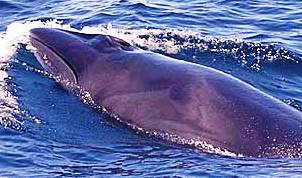 Sei
Whale
(Balaenoptera borealis) Endangered- Sei whales can be found in both the
Atlantic and Pacific oceans. Preferring deep oceanic water, the sei
whale spends winters in more temperate waters, then migrates to higher
latitudes in the summer. In the western Atlantic, sei whales migrate
from Florida to Labrador and leave northern waters before September.
They are normally found far off shore. They frequently feed on the
surface, trapping schools of small fish or plankton in their mouths. The
average length of male sei whales in the Atlantic Ocean is 13 m (40
ft.), but females are slightly larger. The longest sei whale yet
measured, a female, was 20 m (65 ft.). The sei whale is a smaller
relative of the fin whale. Sei
Whale
(Balaenoptera borealis) Endangered- Sei whales can be found in both the
Atlantic and Pacific oceans. Preferring deep oceanic water, the sei
whale spends winters in more temperate waters, then migrates to higher
latitudes in the summer. In the western Atlantic, sei whales migrate
from Florida to Labrador and leave northern waters before September.
They are normally found far off shore. They frequently feed on the
surface, trapping schools of small fish or plankton in their mouths. The
average length of male sei whales in the Atlantic Ocean is 13 m (40
ft.), but females are slightly larger. The longest sei whale yet
measured, a female, was 20 m (65 ft.). The sei whale is a smaller
relative of the fin whale. 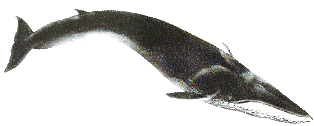 Finback
Whale
(Balaenoptera physalus) Endangered- The fin whale is one of the rorquals,
a family that includes the humpback whale, sei whale, and minke whale.
Rorquals all have a dorsal fin and throat grooves that expand when the
animal is feeding. The fin, or finback whale is second only to the blue
whale in size and weight. Adult males measure up to 78 feet in the
northern hemisphere, and 88 feet in the southern hemisphere. Females
are slightly larger than males. Weight for both sexes is between 50-70
tonsThe
fin whale is long, sleek, and streamlined, with a V-shaped head which is
flat on top. A single ridge extends from the blowhole to the tip of the
rostrum (upper jaw). Among the fastest of the great whales, it is
capable of bursts of speed of up to 23 mph leading to its description
as the "greyhound of the sea." Its most unusual characteristic is the
asymmetrical coloring of the lower jaw, which is white or creamy yellow
on the right side and mottled black on the left side. Fin whales are
found in all oceans of the world.
Fin whales feed mainly on small shrimp-like creatures called krill or
euphausiids and schooling fish. Finback
Whale
(Balaenoptera physalus) Endangered- The fin whale is one of the rorquals,
a family that includes the humpback whale, sei whale, and minke whale.
Rorquals all have a dorsal fin and throat grooves that expand when the
animal is feeding. The fin, or finback whale is second only to the blue
whale in size and weight. Adult males measure up to 78 feet in the
northern hemisphere, and 88 feet in the southern hemisphere. Females
are slightly larger than males. Weight for both sexes is between 50-70
tonsThe
fin whale is long, sleek, and streamlined, with a V-shaped head which is
flat on top. A single ridge extends from the blowhole to the tip of the
rostrum (upper jaw). Among the fastest of the great whales, it is
capable of bursts of speed of up to 23 mph leading to its description
as the "greyhound of the sea." Its most unusual characteristic is the
asymmetrical coloring of the lower jaw, which is white or creamy yellow
on the right side and mottled black on the left side. Fin whales are
found in all oceans of the world.
Fin whales feed mainly on small shrimp-like creatures called krill or
euphausiids and schooling fish.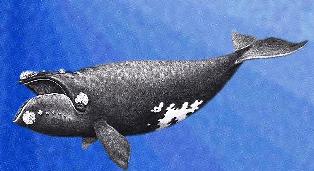 North
Atlantic Right Whale
(Eubalaena glacialis) Endangered- The North Atlantic right
whale weighs up to 220,000 pounds and is up to 56 feet long. It can
easily be distinguished from the other great whales by its lack of a
dorsal fin or dorsal ridge; its stout, robust stature; and the presence
of distinctive growths on the head known as "callosities". Right whales
are individually identifiable by their pattern of callosities. The right
whale is usually found in temperate waters. It is found closer to land
than are most large whales, especially during the breeding season.
Calves may be born in the protected waters of a shallow bay. The North
Atlantic right whale feeds alone or in small groups. Its food consists
primarily of small marine crustaceans. Right whales are " skim feeders",
moving slowly through the water with their mouths partially open,
continuously straining the food items with their long baleen. The North
Atlantic right whale migrates to more northerly latitudes for summer
feeding, and back south to temperate waters in the fall and winter for
breeding. A relatively slow swimmer, the North Atlantic right whale
averages about 6 miles per hour. North
Atlantic Right Whale
(Eubalaena glacialis) Endangered- The North Atlantic right
whale weighs up to 220,000 pounds and is up to 56 feet long. It can
easily be distinguished from the other great whales by its lack of a
dorsal fin or dorsal ridge; its stout, robust stature; and the presence
of distinctive growths on the head known as "callosities". Right whales
are individually identifiable by their pattern of callosities. The right
whale is usually found in temperate waters. It is found closer to land
than are most large whales, especially during the breeding season.
Calves may be born in the protected waters of a shallow bay. The North
Atlantic right whale feeds alone or in small groups. Its food consists
primarily of small marine crustaceans. Right whales are " skim feeders",
moving slowly through the water with their mouths partially open,
continuously straining the food items with their long baleen. The North
Atlantic right whale migrates to more northerly latitudes for summer
feeding, and back south to temperate waters in the fall and winter for
breeding. A relatively slow swimmer, the North Atlantic right whale
averages about 6 miles per hour.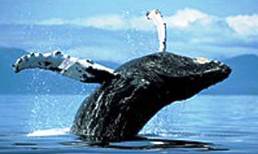 Humpback
Whale
(Megaptera novaeangliae) Endangered- he humpback whale is a
baleen whale and a rorqual whale that sings amazing songs. It performs
complex and cooperative feeding techniques. The humpback has a bulky
head with bumpy protuberances (tubercles), each with a bristle.
Humpbacks are acrobats of the ocean, breaching and slapping the water.
They live in pods and have 2 blowholes. The name humpback describes the
motion it makes as it arches its back out of the water in preparation
for a dive. Humpback whales grow to be about 52 feet long, weighing
30-50 tons. The females are slightly larger than males, Humpbacks come
in 4 different color schemes, ranging from white to gray to black to
mottled. Humpback
Whale
(Megaptera novaeangliae) Endangered- he humpback whale is a
baleen whale and a rorqual whale that sings amazing songs. It performs
complex and cooperative feeding techniques. The humpback has a bulky
head with bumpy protuberances (tubercles), each with a bristle.
Humpbacks are acrobats of the ocean, breaching and slapping the water.
They live in pods and have 2 blowholes. The name humpback describes the
motion it makes as it arches its back out of the water in preparation
for a dive. Humpback whales grow to be about 52 feet long, weighing
30-50 tons. The females are slightly larger than males, Humpbacks come
in 4 different color schemes, ranging from white to gray to black to
mottled.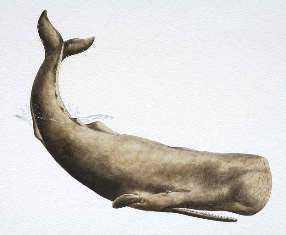 Sperm
Whale
(Physeter macrocephalus) Endangered- The sperm whale is a
toothed whale that lives in pods. It has a huge brain that weighs about
20 pounds, the largest brain of any animal. The sperm whale has a single
blowhole that is s-shaped and about 20 inches long. The blowhole is
located on the left side of the front if its huge head. The sperm whale
has a 4-12 inch thick layer of blubber. Sperm whales produce ambergris,
a dark, waxy substance (related to cholesterol) that is produced in the
lower intestines, and is sometimes found containing squid beaks.
Ambergris may help protect the sperm whale from the stings on the giant
squid, its major food. Large lumps of ambergris may be vomited up by the
sperm whale. Sperm whales are the largest toothed whales. Adult males
grow to be about 50-60 feet long, weighing about 40-50 tons . Females
are smaller, about 33-40 feet long, weighing about 14-18 tons The
fictional Moby Dick was a sperm whale. Sperm
Whale
(Physeter macrocephalus) Endangered- The sperm whale is a
toothed whale that lives in pods. It has a huge brain that weighs about
20 pounds, the largest brain of any animal. The sperm whale has a single
blowhole that is s-shaped and about 20 inches long. The blowhole is
located on the left side of the front if its huge head. The sperm whale
has a 4-12 inch thick layer of blubber. Sperm whales produce ambergris,
a dark, waxy substance (related to cholesterol) that is produced in the
lower intestines, and is sometimes found containing squid beaks.
Ambergris may help protect the sperm whale from the stings on the giant
squid, its major food. Large lumps of ambergris may be vomited up by the
sperm whale. Sperm whales are the largest toothed whales. Adult males
grow to be about 50-60 feet long, weighing about 40-50 tons . Females
are smaller, about 33-40 feet long, weighing about 14-18 tons The
fictional Moby Dick was a sperm whale.
|
|
|
Advertise | Privacy Statement | Dog Encyclopedia | Video |Contact | Alaska Nature |
|